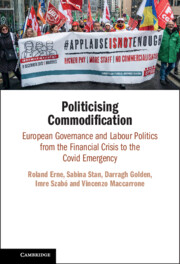 Politicising Commodification
Politicising Commodification Book contents
- Politicising Commodification
- Politicising Commodification
- Copyright page
- Contents
- Figure and Tables
- Tables in the Online Appendix
- Authors
- Acknowledgements
- Abbreviations
- 1 Introduction
- Part I Analytical Framework
- Part II EU Economic Governance in Two Policy Areas
- Part III EU Economic Governance in Three Sectors
- Part IV Comparative Analysis and Post-Pandemic Developments
- Glossary
- References
- Index
- References
References
Published online by Cambridge University Press: 30 May 2024
- Politicising Commodification
- Politicising Commodification
- Copyright page
- Contents
- Figure and Tables
- Tables in the Online Appendix
- Authors
- Acknowledgements
- Abbreviations
- 1 Introduction
- Part I Analytical Framework
- Part II EU Economic Governance in Two Policy Areas
- Part III EU Economic Governance in Three Sectors
- Part IV Comparative Analysis and Post-Pandemic Developments
- Glossary
- References
- Index
- References
Summary
- Type
- Chapter
- Information
- Politicising CommodificationEuropean Governance and Labour Politics from the Financial Crisis to the Covid Emergency, pp. 363 - 392Publisher: Cambridge University PressPrint publication year: 2024
- Creative Commons
- This content is Open Access and distributed under the terms of the Creative Commons Attribution licence CC-BY-NC-ND 4.0 https://creativecommons.org/cclicenses/


